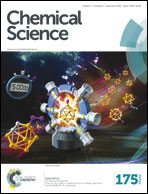Novel benzo-bis(1,2,5-thiadiazole) fluorophores for in vivo NIR-II imaging of cancer†
Abstract
Optical imaging of diseases represents a highly dynamic and multidisciplinary research area, and second near-infrared window (NIR-II, 1000–1700 nm) imaging is at the forefront of the research on optical imaging techniques. Small-molecule based NIR-II (1000–1700 nm) dyes are highly promising candidates for in vivo molecular imaging because of their high biocompatibility, fast excretion, and high clinical translation ability. However, research reports on small-molecule based NIR-II dyes and probes are rare. Herein, we designed a series of fluorescent compounds (Q1, Q2, Q3, and Q4) and investigated the relationships between their structures and absorption/fluorescence properties. Q4 (maximum emission at 1100 nm) stood out as the dye with the best physical properties and thus was selected as a scaffold for the facile construction of two types of water-soluble and biocompatible NIR-II probes (Q4NPs and SCH1100). Highly specific gastrin-releasing peptide receptor (GRPR) targeted NIR-II imaging of prostate cancer in living mice was achieved using the small-molecule probe SCH1100, which represents the first small peptide based NIR-II probe for targeted cancer imaging. The attractive imaging properties of Q4-based NIR-II probes open up many opportunities for molecular imaging and clinical translation in the unique NIR-II window.


 Please wait while we load your content...
Please wait while we load your content...